Attached files
| file | filename |
|---|---|
| EX-99.1 - EXHIBIT 99.1 - TIPTREE INC. | ex991er12312019.htm |
| 8-K - 8-K - TIPTREE INC. | a8ker12312019.htm |
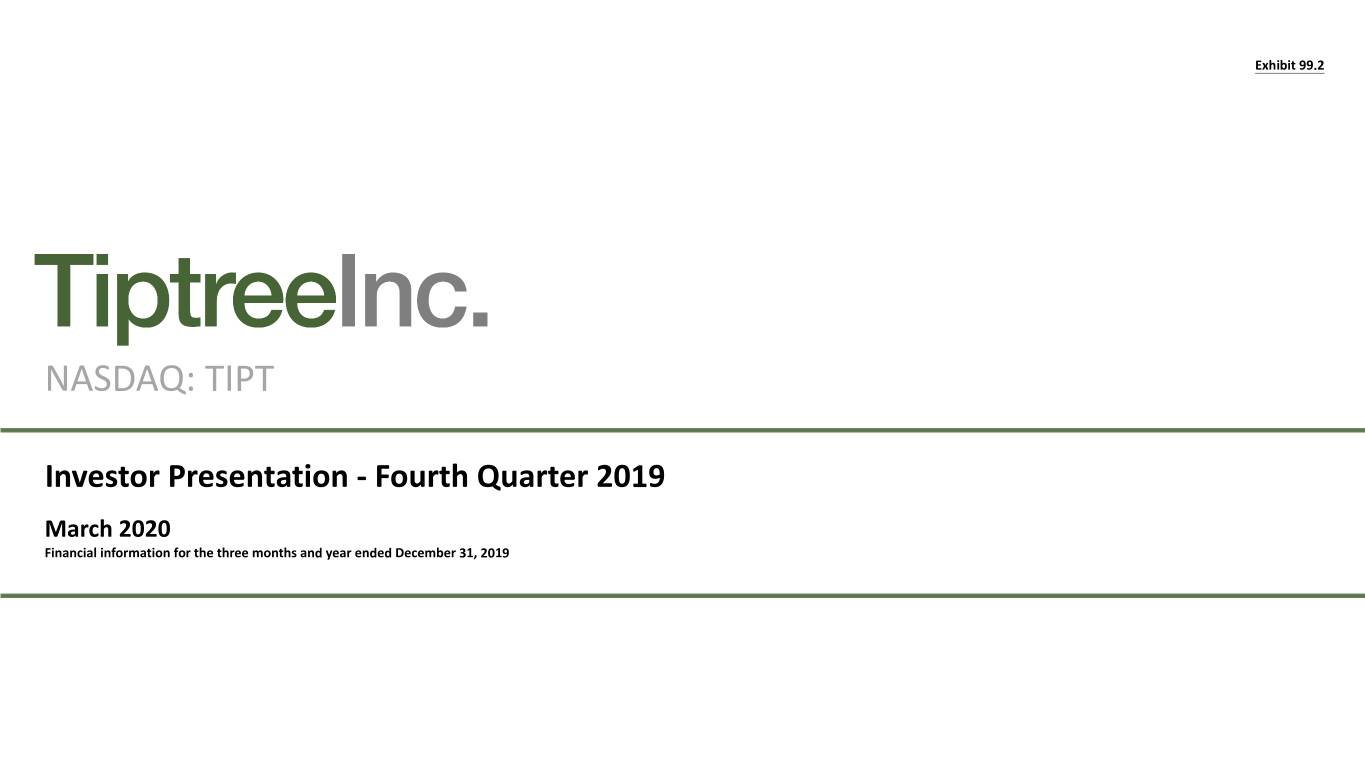
Exhibit 99.2 NASDAQ: TIPT Investor Presentation - Fourth Quarter 2019 March 2020 Financial information for the three months and year ended December 31, 2019
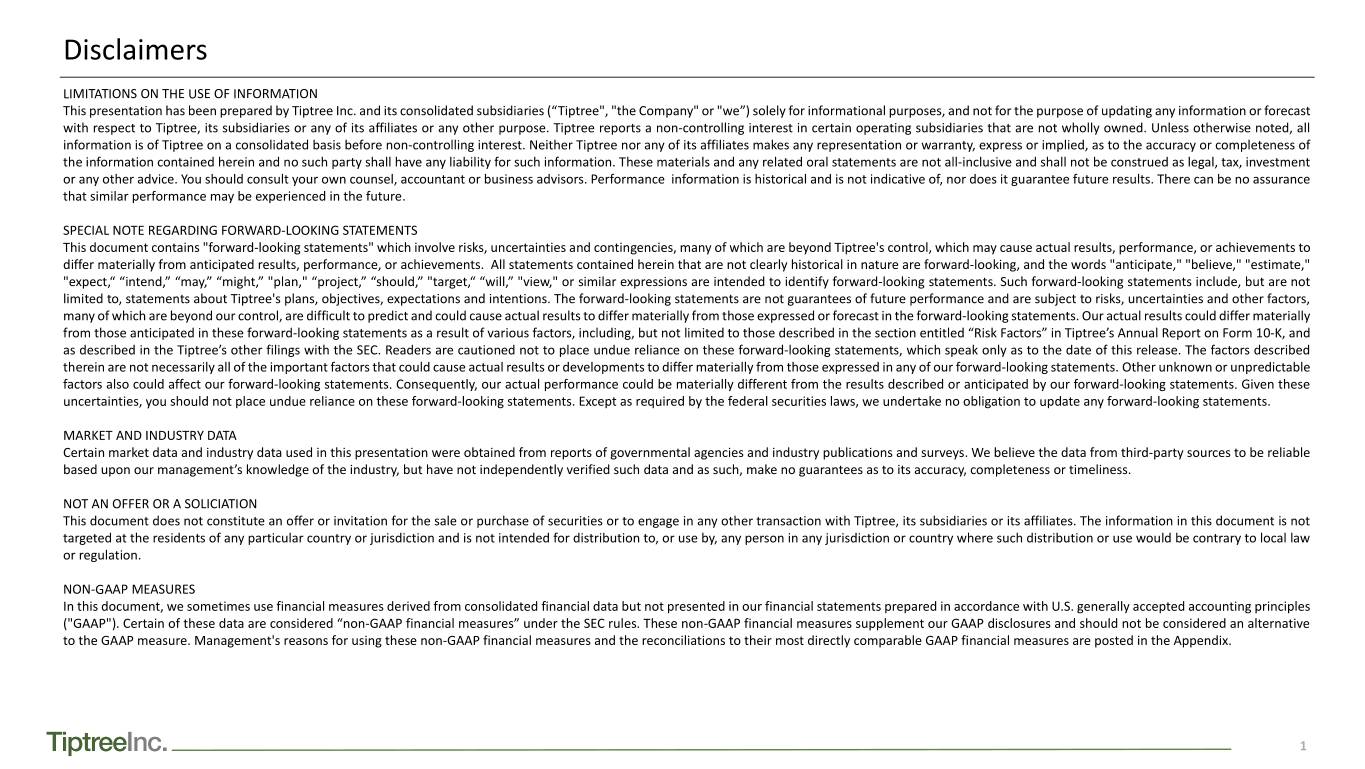
Disclaimers LIMITATIONS ON THE USE OF INFORMATION This presentation has been prepared by Tiptree Inc. and its consolidated subsidiaries (“Tiptree", "the Company" or "we”) solely for informational purposes, and not for the purpose of updating any information or forecast with respect to Tiptree, its subsidiaries or any of its affiliates or any other purpose. Tiptree reports a non-controlling interest in certain operating subsidiaries that are not wholly owned. Unless otherwise noted, all information is of Tiptree on a consolidated basis before non-controlling interest. Neither Tiptree nor any of its affiliates makes any representation or warranty, express or implied, as to the accuracy or completeness of the information contained herein and no such party shall have any liability for such information. These materials and any related oral statements are not all-inclusive and shall not be construed as legal, tax, investment or any other advice. You should consult your own counsel, accountant or business advisors. Performance information is historical and is not indicative of, nor does it guarantee future results. There can be no assurance that similar performance may be experienced in the future. SPECIAL NOTE REGARDING FORWARD-LOOKING STATEMENTS This document contains "forward-looking statements" which involve risks, uncertainties and contingencies, many of which are beyond Tiptree's control, which may cause actual results, performance, or achievements to differ materially from anticipated results, performance, or achievements. All statements contained herein that are not clearly historical in nature are forward-looking, and the words "anticipate," "believe," "estimate," "expect,“ “intend,” “may,” “might,” "plan," “project,” “should,” "target,“ “will,” "view," or similar expressions are intended to identify forward-looking statements. Such forward-looking statements include, but are not limited to, statements about Tiptree's plans, objectives, expectations and intentions. The forward-looking statements are not guarantees of future performance and are subject to risks, uncertainties and other factors, many of which are beyond our control, are difficult to predict and could cause actual results to differ materially from those expressed or forecast in the forward-looking statements. Our actual results could differ materially from those anticipated in these forward-looking statements as a result of various factors, including, but not limited to those described in the section entitled “Risk Factors” in Tiptree’s Annual Report on Form 10-K, and as described in the Tiptree’s other filings with the SEC. Readers are cautioned not to place undue reliance on these forward-looking statements, which speak only as to the date of this release. The factors described therein are not necessarily all of the important factors that could cause actual results or developments to differ materially from those expressed in any of our forward-looking statements. Other unknown or unpredictable factors also could affect our forward-looking statements. Consequently, our actual performance could be materially different from the results described or anticipated by our forward-looking statements. Given these uncertainties, you should not place undue reliance on these forward-looking statements. Except as required by the federal securities laws, we undertake no obligation to update any forward-looking statements. MARKET AND INDUSTRY DATA Certain market data and industry data used in this presentation were obtained from reports of governmental agencies and industry publications and surveys. We believe the data from third-party sources to be reliable based upon our management’s knowledge of the industry, but have not independently verified such data and as such, make no guarantees as to its accuracy, completeness or timeliness. NOT AN OFFER OR A SOLICIATION This document does not constitute an offer or invitation for the sale or purchase of securities or to engage in any other transaction with Tiptree, its subsidiaries or its affiliates. The information in this document is not targeted at the residents of any particular country or jurisdiction and is not intended for distribution to, or use by, any person in any jurisdiction or country where such distribution or use would be contrary to local law or regulation. NON-GAAP MEASURES In this document, we sometimes use financial measures derived from consolidated financial data but not presented in our financial statements prepared in accordance with U.S. generally accepted accounting principles ("GAAP"). Certain of these data are considered “non-GAAP financial measures” under the SEC rules. These non-GAAP financial measures supplement our GAAP disclosures and should not be considered an alternative to the GAAP measure. Management's reasons for using these non-GAAP financial measures and the reconciliations to their most directly comparable GAAP financial measures are posted in the Appendix. 1
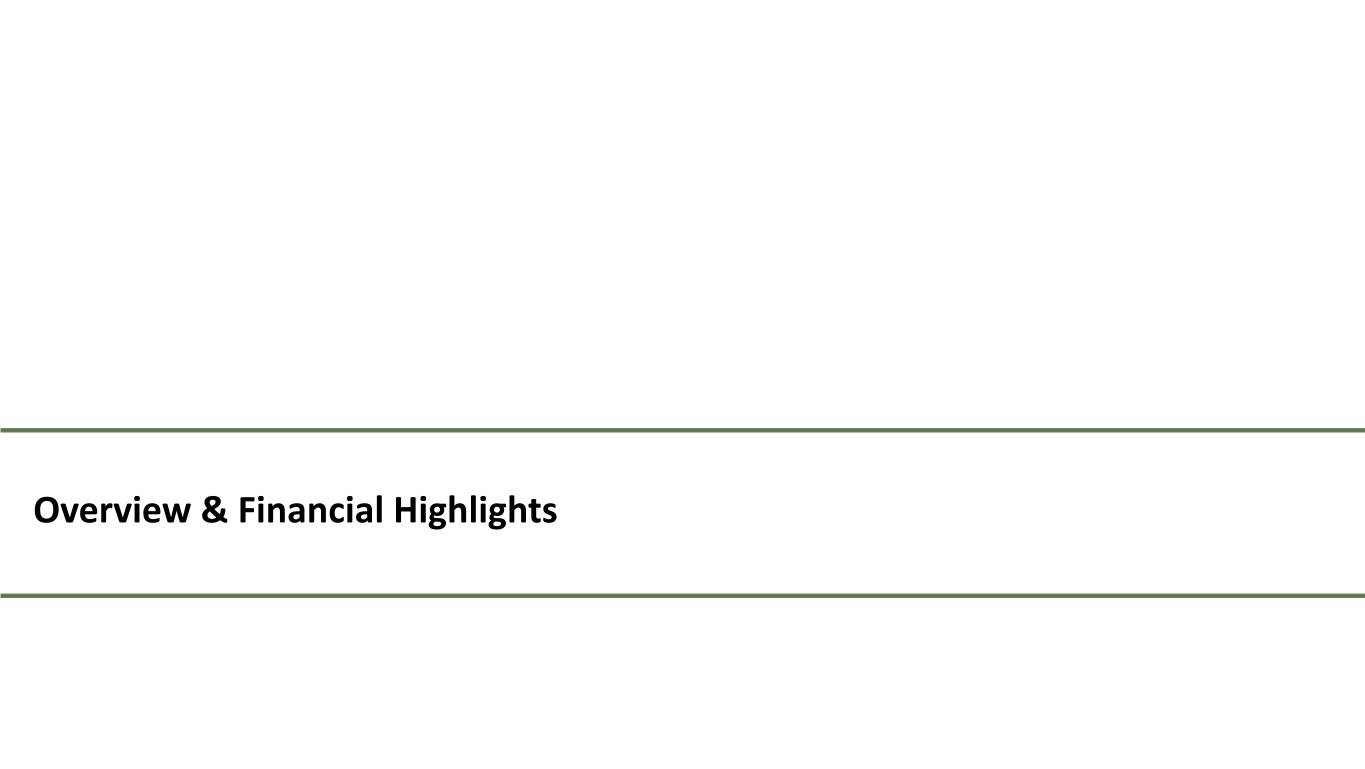
Overview & Financial Highlights
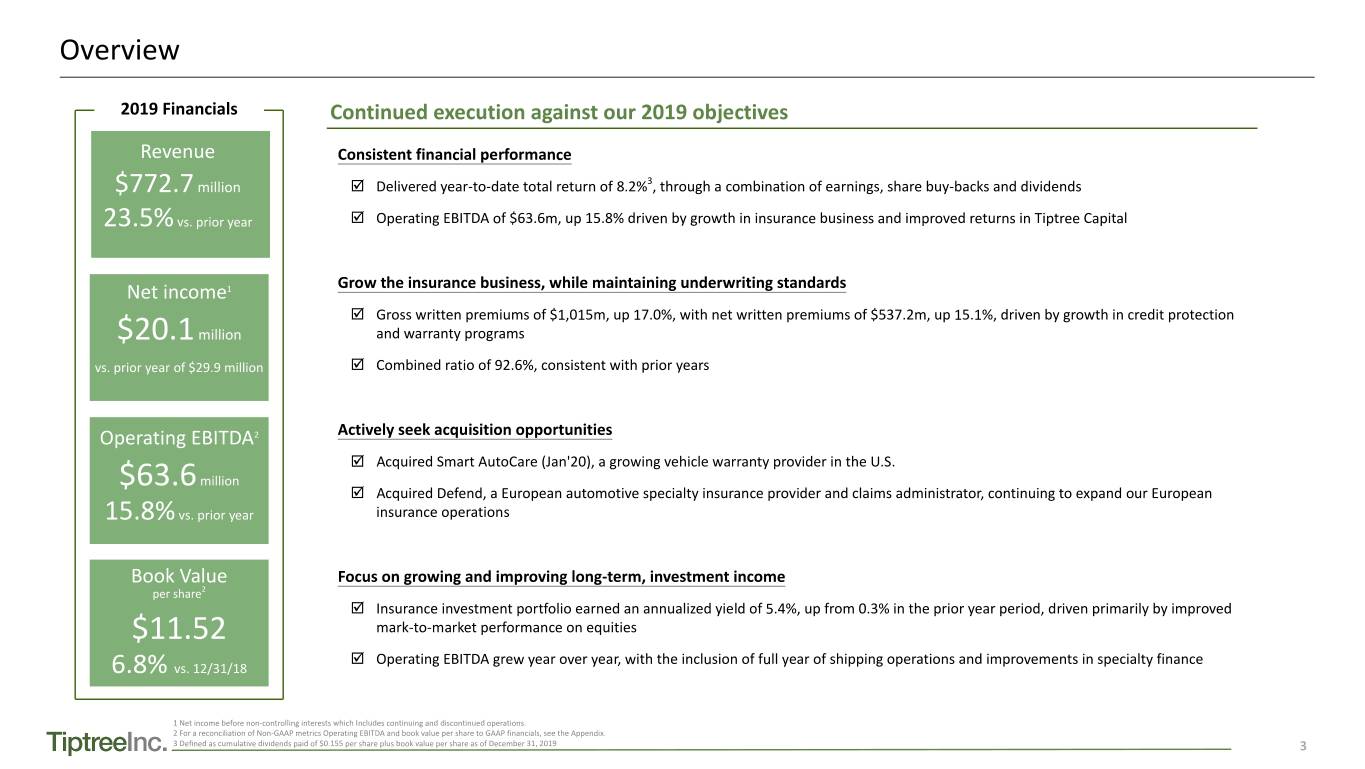
Overview 2019 Financials Continued execution against our 2019 objectives Revenue Consistent financial performance þ 3 $772.7 million Delivered year-to-date total return of 8.2% , through a combination of earnings, share buy-backs and dividends þ 23.5% vs. prior year Operating EBITDA of $63.6m, up 15.8% driven by growth in insurance business and improved returns in Tiptree Capital Grow the insurance business, while maintaining underwriting standards Net income1 þ Gross written premiums of $1,015m, up 17.0%, with net written premiums of $537.2m, up 15.1%, driven by growth in credit protection $20.1 million and warranty programs þ vs. prior year of $29.9 million Combined ratio of 92.6%, consistent with prior years Actively seek acquisition opportunities Operating EBITDA2 þ Acquired Smart AutoCare (Jan'20), a growing vehicle warranty provider in the U.S. $63.6 million þ Acquired Defend, a European automotive specialty insurance provider and claims administrator, continuing to expand our European 15.8% vs. prior year insurance operations Book Value Focus on growing and improving long-term, investment income per share2 þ Insurance investment portfolio earned an annualized yield of 5.4%, up from 0.3% in the prior year period, driven primarily by improved $11.52 mark-to-market performance on equities þ Operating EBITDA grew year over year, with the inclusion of full year of shipping operations and improvements in specialty finance 6.8% vs. 12/31/18 1 Net income before non-controlling interests which Includes continuing and discontinued operations. 2 For a reconciliation of Non-GAAP metrics Operating EBITDA and book value per share to GAAP financials, see the Appendix. 3 Defined as cumulative dividends paid of $0.155 per share plus book value per share as of December 31, 2019 3
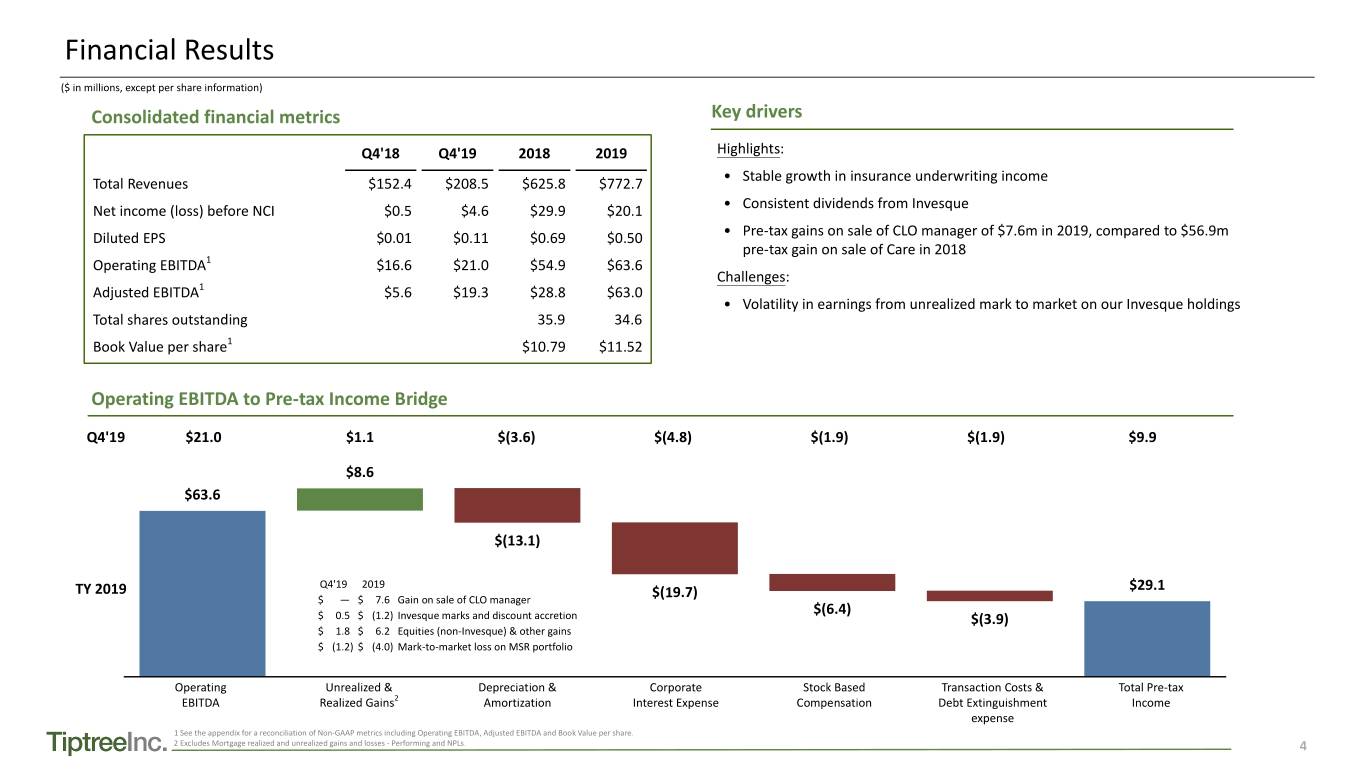
Financial Results ($ in millions, except per share information) Consolidated financial metrics Key drivers Q4'18 Q4'19 2018 2019 Highlights: • Stable growth in insurance underwriting income Total Revenues $152.4 $208.5 $625.8 $772.7 Net income (loss) before NCI $0.5 $4.6 $29.9 $20.1 • Consistent dividends from Invesque Diluted EPS $0.01 $0.11 $0.69 $0.50 • Pre-tax gains on sale of CLO manager of $7.6m in 2019, compared to $56.9m pre-tax gain on sale of Care in 2018 Operating EBITDA1 $16.6 $21.0 $54.9 $63.6 Challenges: Adjusted EBITDA1 $5.6 $19.3 $28.8 $63.0 • Volatility in earnings from unrealized mark to market on our Invesque holdings Total shares outstanding 35.9 34.6 Book Value per share1 $10.79 $11.52 Operating EBITDA to Pre-tax Income Bridge Q4'19 $21.0 $1.1 $(3.6) $(4.8) $(1.9) $(1.9) $9.9 $8.6 $63.6 $(13.1) TY 2019 Q4'19 2019 $29.1 $ — $ 7.6 Gain on sale of CLO manager $(19.7) $(6.4) $ 0.5 $ (1.2) Invesque marks and discount accretion $(3.9) $ 1.8 $ 6.2 Equities (non-Invesque) & other gains $ (1.2) $ (4.0) Mark-to-market loss on MSR portfolio Operating Unrealized & Depreciation & Corporate Stock Based Transaction Costs & Total Pre-tax EBITDA Realized Gains2 Amortization Interest Expense Compensation Debt Extinguishment Income expense 1 See the appendix for a reconciliation of Non-GAAP metrics including Operating EBITDA, Adjusted EBITDA and Book Value per share. 2 Excludes Mortgage realized and unrealized gains and losses - Performing and NPLs. 4
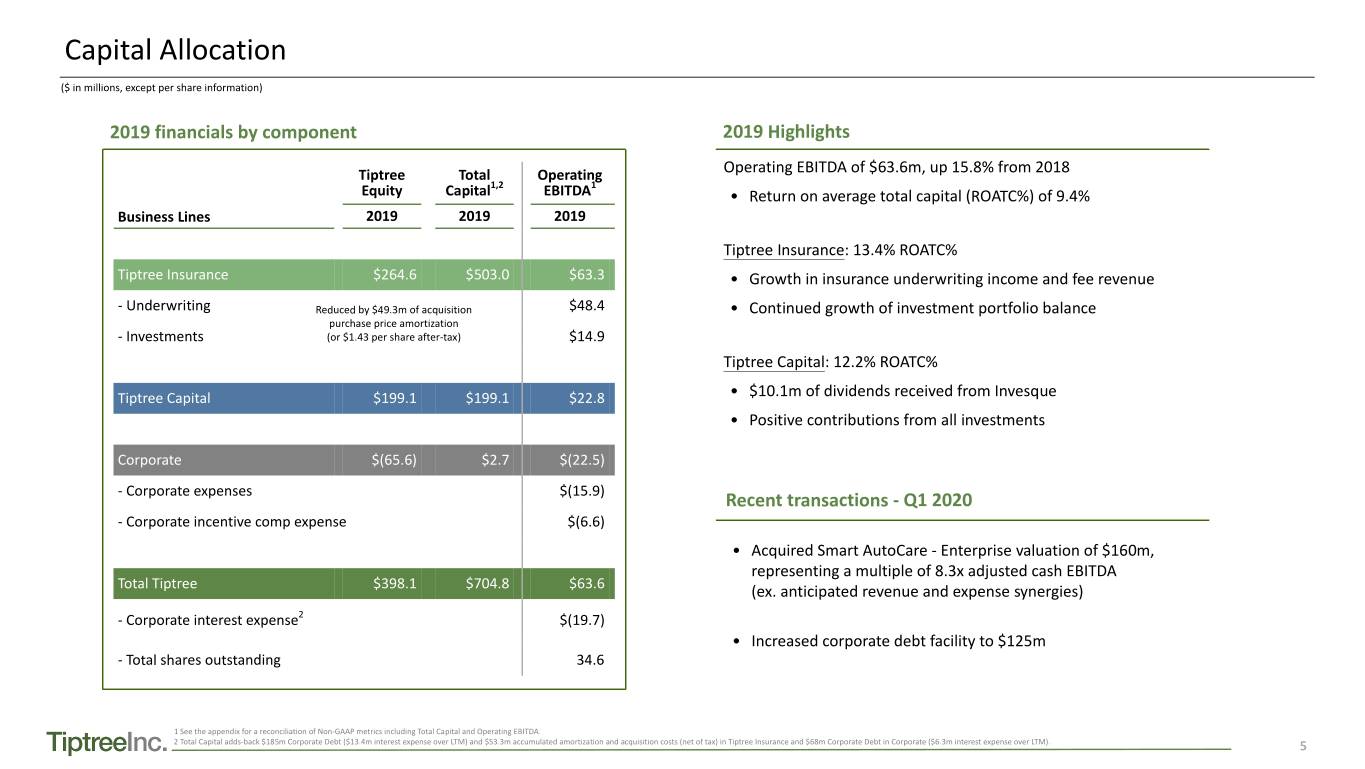
Capital Allocation ($ in millions, except per share information) 2019 financials by component 2019 Highlights Tiptree Total Operating Operating EBITDA of $63.6m, up 15.8% from 2018 1,2 1 Equity Capital EBITDA • Return on average total capital (ROATC%) of 9.4% Business Lines 2019 2019 2019 Tiptree Insurance: 13.4% ROATC% Tiptree Insurance $264.6 $503.0 $63.3 • Growth in insurance underwriting income and fee revenue - Underwriting Reduced by $49.3m of acquisition $48.4 • Continued growth of investment portfolio balance purchase price amortization - Investments (or $1.43 per share after-tax) $14.9 Tiptree Capital: 12.2% ROATC% Tiptree Capital $199.1 $199.1 $22.8 • $10.1m of dividends received from Invesque • Positive contributions from all investments Corporate $(65.6) $2.7 $(22.5) - Corporate expenses $(15.9) Recent transactions - Q1 2020 - Corporate incentive comp expense $(6.6) • Acquired Smart AutoCare - Enterprise valuation of $160m, representing a multiple of 8.3x adjusted cash EBITDA Total Tiptree $398.1 $704.8 $63.6 (ex. anticipated revenue and expense synergies) - Corporate interest expense2 $(19.7) • Increased corporate debt facility to $125m - Total shares outstanding 34.6 1 See the appendix for a reconciliation of Non-GAAP metrics including Total Capital and Operating EBITDA. 2 Total Capital adds-back $185m Corporate Debt ($13.4m interest expense over LTM) and $53.3m accumulated amortization and acquisition costs (net of tax) in Tiptree Insurance and $68m Corporate Debt in Corporate ($6.3m interest expense over LTM). 5

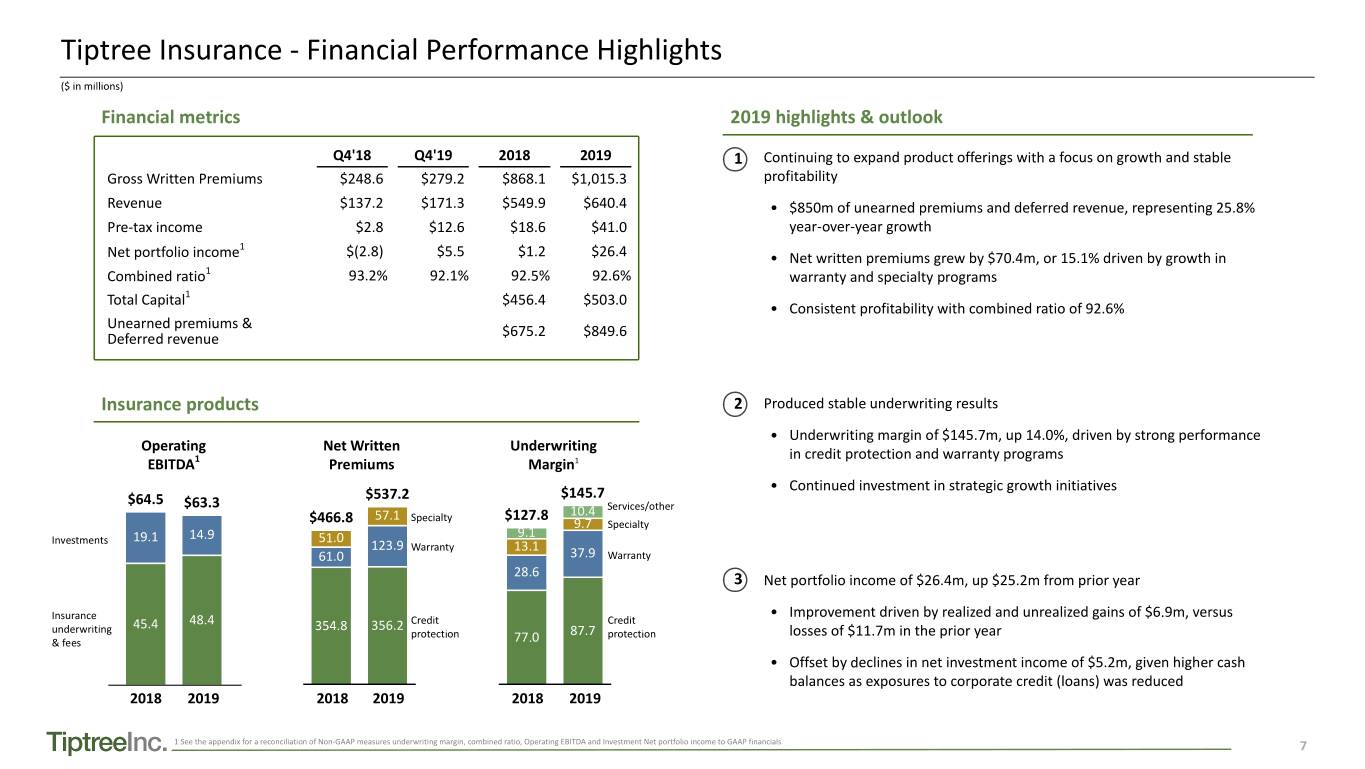
Tiptree Insurance - Financial Performance Highlights ($ in millions) Financial metrics 2019 highlights & outlook Q4'18 Q4'19 2018 2019 1 Continuing to expand product offerings with a focus on growth and stable Gross Written Premiums $248.6 $279.2 $868.1 $1,015.3 profitability Revenue $137.2 $171.3 $549.9 $640.4 • $850m of unearned premiums and deferred revenue, representing 25.8% Pre-tax income $2.8 $12.6 $18.6 $41.0 year-over-year growth 1 Net portfolio income $(2.8) $5.5 $1.2 $26.4 • Net written premiums grew by $70.4m, or 15.1% driven by growth in Combined ratio1 93.2% 92.1% 92.5% 92.6% warranty and specialty programs Total Capital1 $456.4 $503.0 • Consistent profitability with combined ratio of 92.6% Unearned premiums & Deferred revenue $675.2 $849.6 Insurance products 2 Produced stable underwriting results • Underwriting margin of $145.7m, up 14.0%, driven by strong performance Operating Net Written Underwriting in credit protection and warranty programs EBITDA1 Premiums Margin1 • Continued investment in strategic growth initiatives $537.2 $145.7 $64.5 $63.3 Services/other 57.1 Specialty $127.8 10.4 $466.8 9.7 Specialty 9.1 Investments 19.1 14.9 51.0 123.9 Warranty 13.1 61.0 37.9 Warranty 28.6 3 Net portfolio income of $26.4m, up $25.2m from prior year Insurance • Improvement driven by realized and unrealized gains of $6.9m, versus 45.4 48.4 354.8 356.2 Credit Credit underwriting protection 87.7 protection losses of $11.7m in the prior year & fees 77.0 • Offset by declines in net investment income of $5.2m, given higher cash balances as exposures to corporate credit (loans) was reduced 2018 2019 2018 2019 2018 2019 1 See the appendix for a reconciliation of Non-GAAP measures underwriting margin, combined ratio, Operating EBITDA and Investment Net portfolio income to GAAP financials. 7
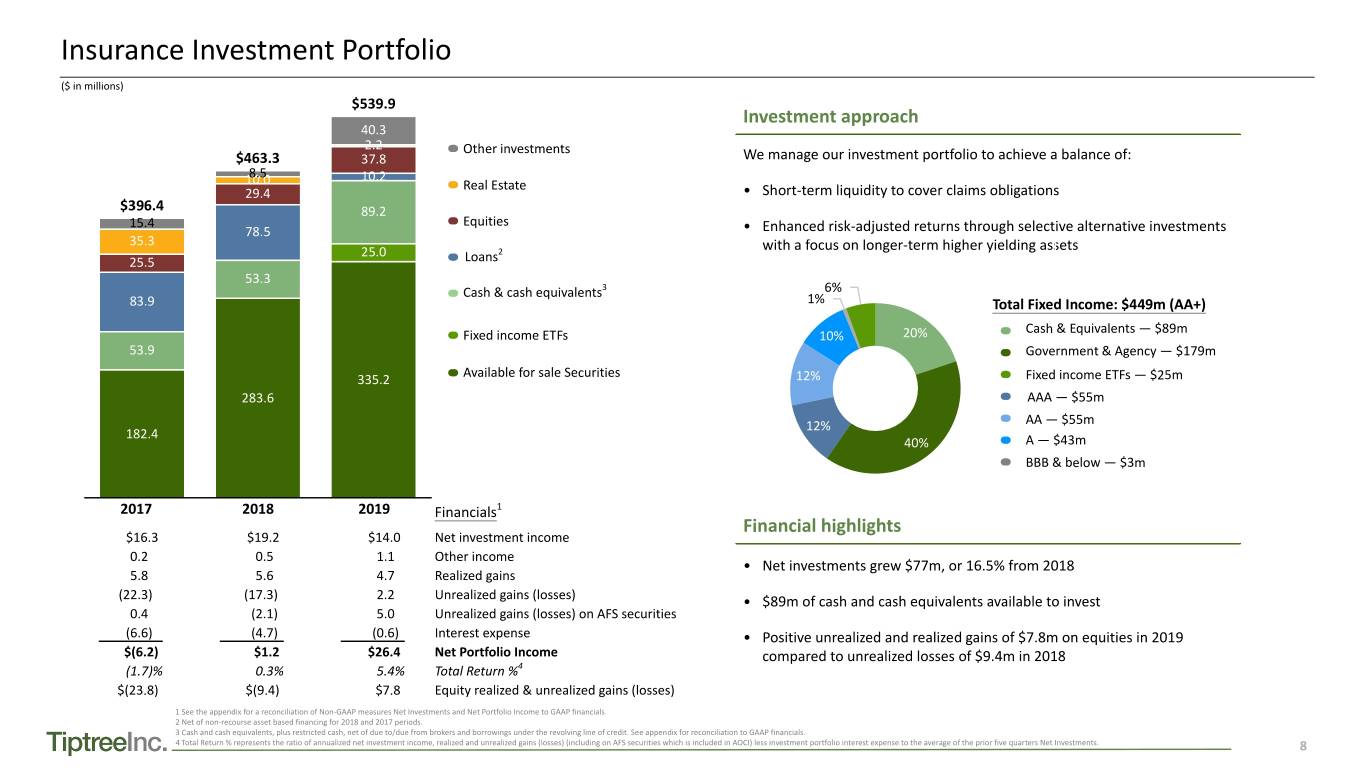
Insurance Investment Portfolio ($ in millions) $539.9 Investment approach 40.3 2.2 Other investments $463.3 37.8 We manage our investment portfolio to achieve a balance of: 8.5 10.2 10.0 Real Estate 29.4 • Short-term liquidity to cover claims obligations $396.4 89.2 15.4 Equities 78.5 • Enhanced risk-adjusted returns through selective alternative investments 35.3 25.0 2 with a focus on longer-term higher yielding assets 25.5 Loans 53.3 Cash & cash equivalents3 6% 83.9 1% Total Fixed Income: $449m (AA+) Cash & Equivalents — $89m Fixed income ETFs 10% 20% 53.9 Government & Agency — $179m Available for sale Securities 335.2 12% Fixed income ETFs — $25m 283.6 AAA — $55m 12% AA — $55m 182.4 40% A — $43m BBB & below — $3m 2017 2018 2019 Financials1 Financial highlights $16.3 $19.2 $14.0 Net investment income 0.2 0.5 1.1 Other income • Net investments grew $77m, or 16.5% from 2018 5.8 5.6 4.7 Realized gains (22.3) (17.3) 2.2 Unrealized gains (losses) • $89m of cash and cash equivalents available to invest 0.4 (2.1) 5.0 Unrealized gains (losses) on AFS securities (6.6) (4.7) (0.6) Interest expense • Positive unrealized and realized gains of $7.8m on equities in 2019 $(6.2) $1.2 $26.4 Net Portfolio Income compared to unrealized losses of $9.4m in 2018 (1.7)% 0.3% 5.4% Total Return %4 $(23.8) $(9.4) $7.8 Equity realized & unrealized gains (losses) 1 See the appendix for a reconciliation of Non-GAAP measures Net Investments and Net Portfolio Income to GAAP financials. 2 Net of non-recourse asset based financing for 2018 and 2017 periods. 3 Cash and cash equivalents, plus restricted cash, net of due to/due from brokers and borrowings under the revolving line of credit. See appendix for reconciliation to GAAP financials. 4 Total Return % represents the ratio of annualized net investment income, realized and unrealized gains (losses) (including on AFS securities which is included in AOCI) less investment portfolio interest expense to the average of the prior five quarters Net Investments. 8
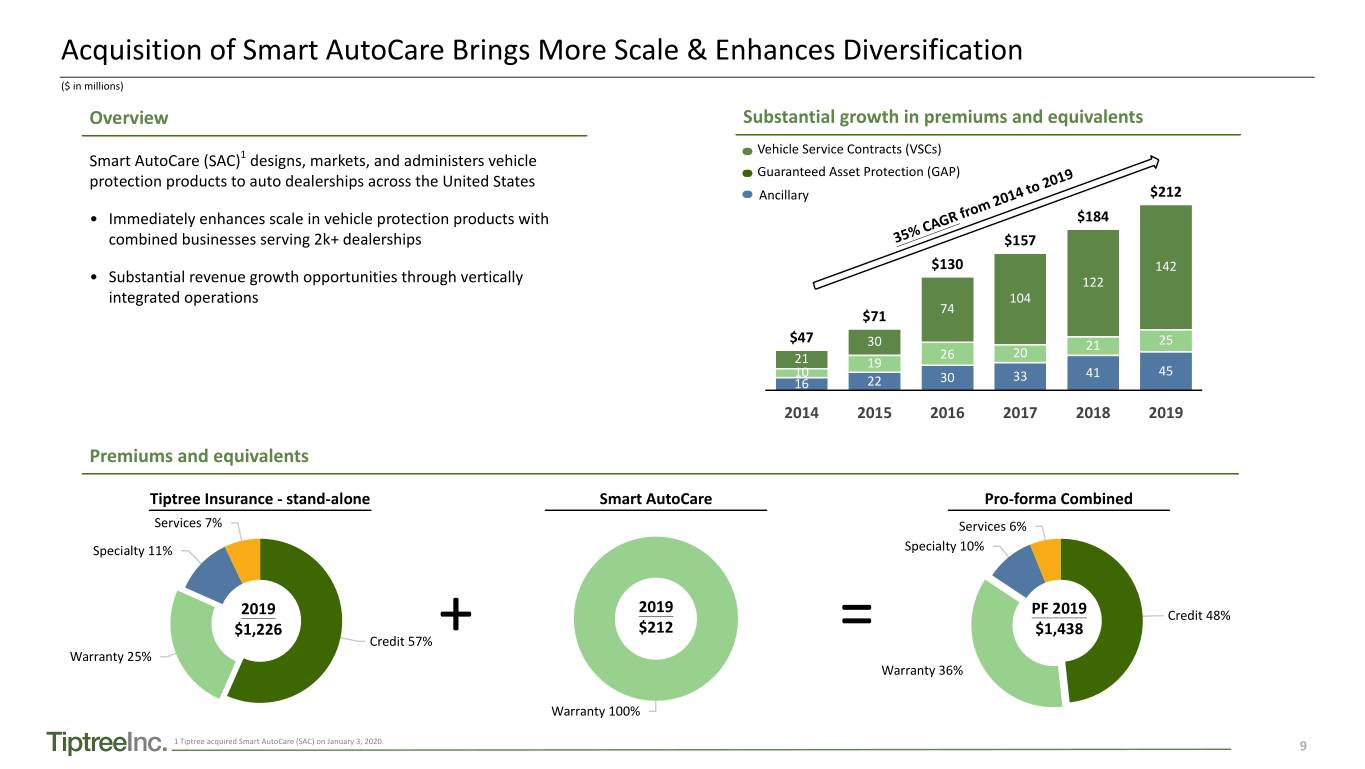
Acquisition of Smart AutoCare Brings More Scale & Enhances Diversification ($ in millions) Overview Substantial growth in premiums and equivalents Vehicle Service Contracts (VSCs) Smart AutoCare (SAC)1 designs, markets, and administers vehicle Guaranteed Asset Protection (GAP) protection products to auto dealerships across the United States Ancillary $212 • Immediately enhances scale in vehicle protection products with from 2014 to 2019 $184 combined businesses serving 2k+ dealerships 35% CAGR $157 $130 142 • Substantial revenue growth opportunities through vertically 122 integrated operations 104 $71 74 $47 30 21 25 26 20 21 19 10 33 41 45 16 22 30 2014 2015 2016 2017 2018 2019 Premiums and equivalents Tiptree Insurance - stand-alone Smart AutoCare Pro-forma Combined Services 7% Services 6% Specialty 11% Specialty 10% 2019 2019 PF 2019 Credit 48% $1,226 $212 $1,438 Credit 57% + = Warranty 25% Warranty 36% Warranty 100% 1 Tiptree acquired Smart AutoCare (SAC) on January 3, 2020. 9

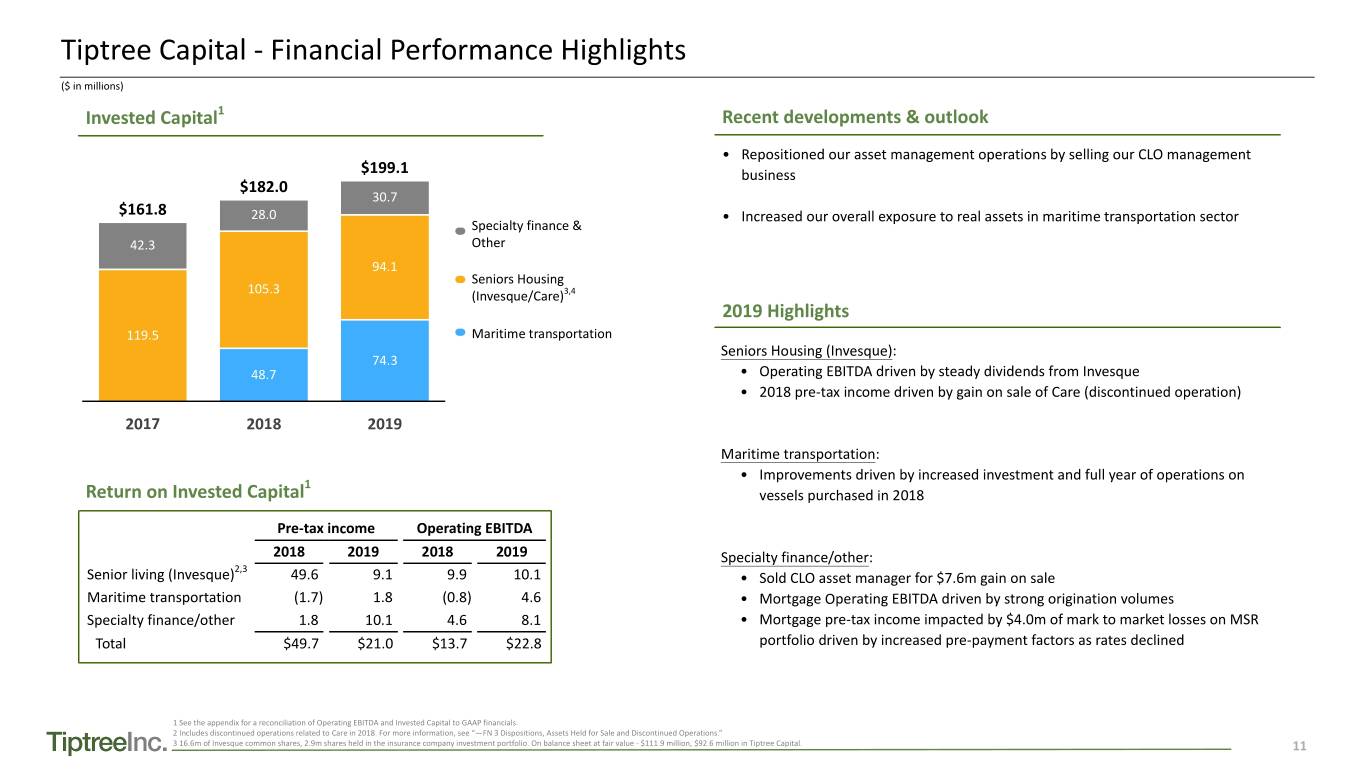
Tiptree Capital - Financial Performance Highlights ($ in millions) Invested Capital1 Recent developments & outlook • Repositioned our asset management operations by selling our CLO management $199.1 business $182.0 30.7 $161.8 28.0 • Increased our overall exposure to real assets in maritime transportation sector Specialty finance & 42.3 Other 94.1 Seniors Housing 105.3 3,4 (Invesque/Care) 2019 Highlights 119.5 Maritime transportation Seniors Housing (Invesque): 74.3 48.7 • Operating EBITDA driven by steady dividends from Invesque • 2018 pre-tax income driven by gain on sale of Care (discontinued operation) 2017 2018 2019 Maritime transportation: • Improvements driven by increased investment and full year of operations on 1 Return on Invested Capital vessels purchased in 2018 Pre-tax income Operating EBITDA 2018 2019 2018 2019 Specialty finance/other: 2,3 Senior living (Invesque) 49.6 9.1 9.9 10.1 • Sold CLO asset manager for $7.6m gain on sale Maritime transportation (1.7) 1.8 (0.8) 4.6 • Mortgage Operating EBITDA driven by strong origination volumes Specialty finance/other 1.8 10.1 4.6 8.1 • Mortgage pre-tax income impacted by $4.0m of mark to market losses on MSR Total $49.7 $21.0 $13.7 $22.8 portfolio driven by increased pre-payment factors as rates declined 1 See the appendix for a reconciliation of Operating EBITDA and Invested Capital to GAAP financials. 2 Includes discontinued operations related to Care in 2018. For more information, see “—FN 3 Dispositions, Assets Held for Sale and Discontinued Operations.” 3 16.6m of Invesque common shares, 2.9m shares held in the insurance company investment portfolio. On balance sheet at fair value - $111.9 million, $92.6 million in Tiptree Capital. 11
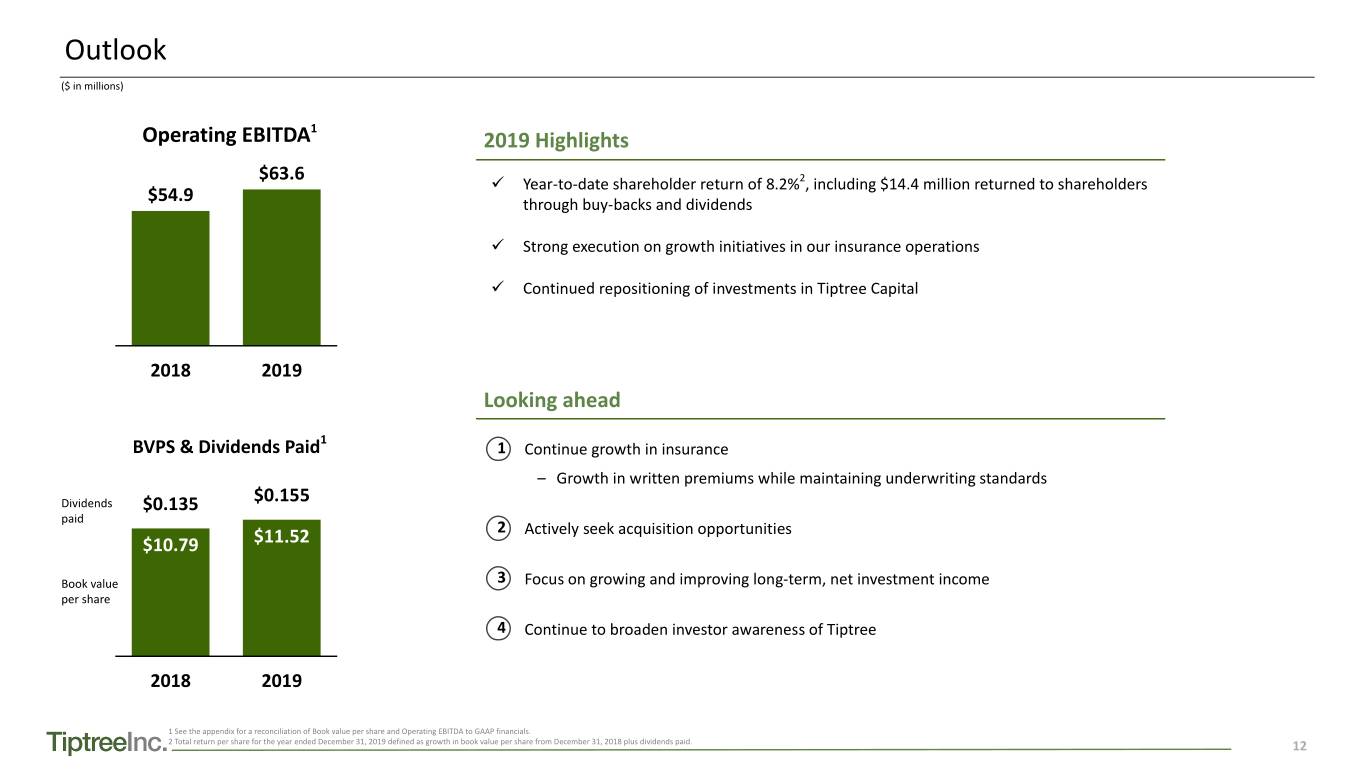
Outlook ($ in millions) 1 Operating EBITDA 2019 Highlights $63.6 2 ü Year-to-date shareholder return of 8.2% , including $14.4 million returned to shareholders $54.9 through buy-backs and dividends ü Strong execution on growth initiatives in our insurance operations ü Continued repositioning of investments in Tiptree Capital 2018 2019 Looking ahead 1 BVPS & Dividends Paid 1• Continue growth in insurance – Growth in written premiums while maintaining underwriting standards $0.155 Dividends $0.135 paid 2• Actively seek acquisition opportunities $10.79 $11.52 Book value 3• Focus on growing and improving long-term, net investment income per share 4• Continue to broaden investor awareness of Tiptree 2018 2019 1 See the appendix for a reconciliation of Book value per share and Operating EBITDA to GAAP financials. 2 Total return per share for the year ended December 31, 2019 defined as growth in book value per share from December 31, 2018 plus dividends paid. 12
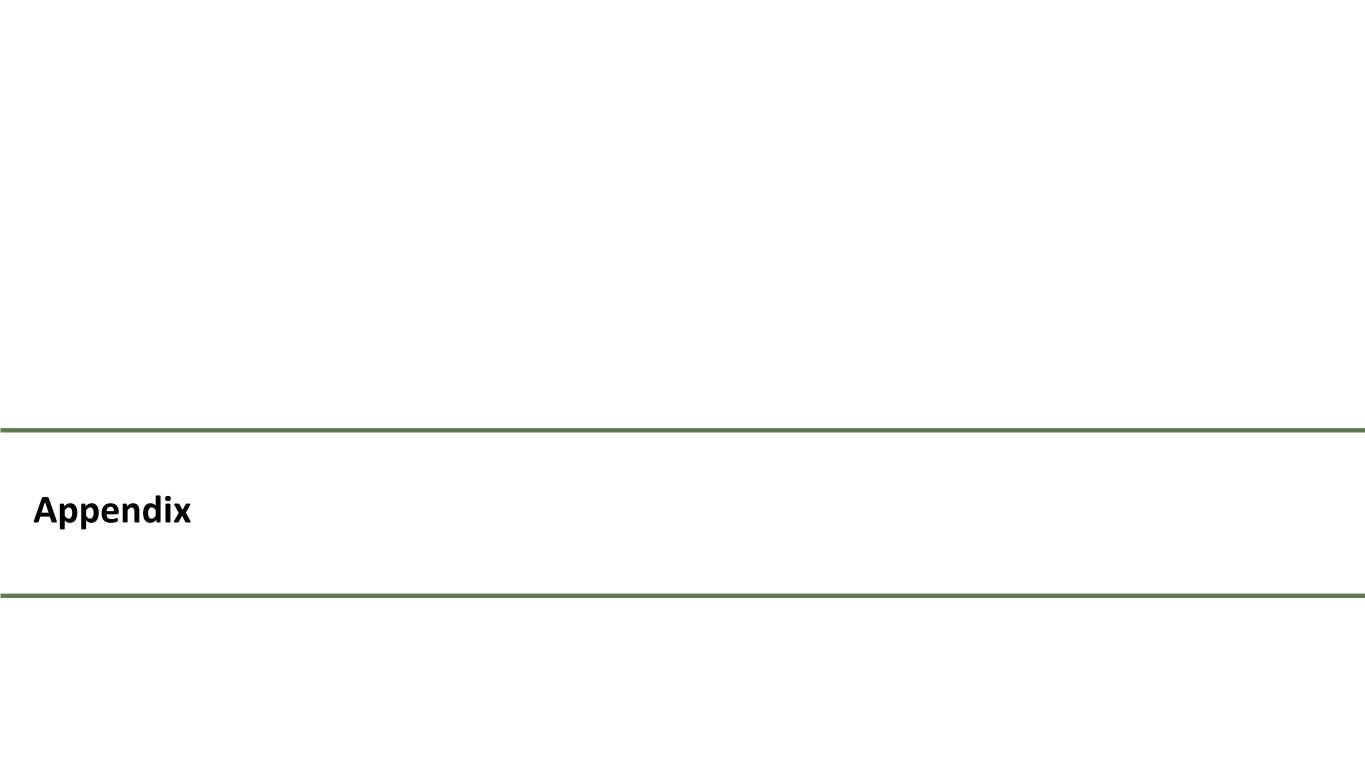
Appendix
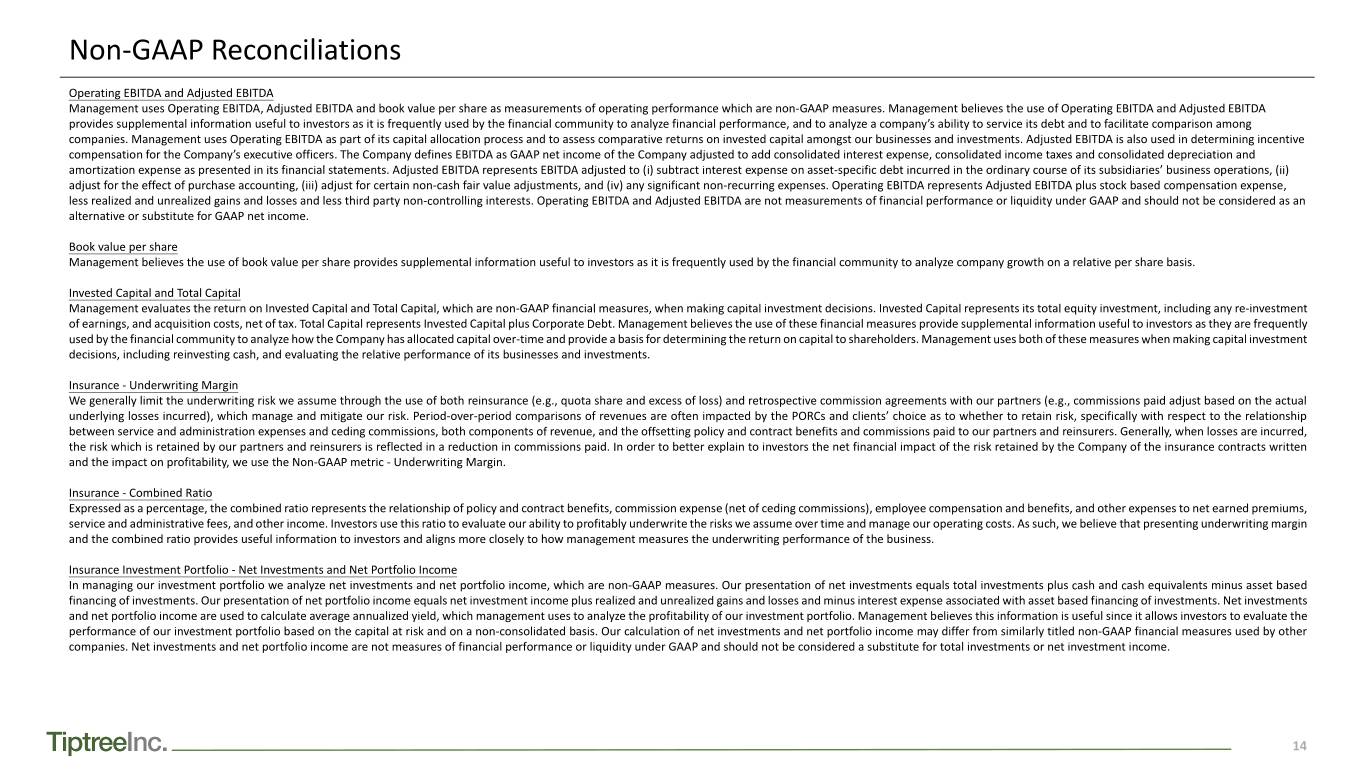
Non-GAAP Reconciliations Operating EBITDA and Adjusted EBITDA Management uses Operating EBITDA, Adjusted EBITDA and book value per share as measurements of operating performance which are non-GAAP measures. Management believes the use of Operating EBITDA and Adjusted EBITDA provides supplemental information useful to investors as it is frequently used by the financial community to analyze financial performance, and to analyze a company’s ability to service its debt and to facilitate comparison among companies. Management uses Operating EBITDA as part of its capital allocation process and to assess comparative returns on invested capital amongst our businesses and investments. Adjusted EBITDA is also used in determining incentive compensation for the Company’s executive officers. The Company defines EBITDA as GAAP net income of the Company adjusted to add consolidated interest expense, consolidated income taxes and consolidated depreciation and amortization expense as presented in its financial statements. Adjusted EBITDA represents EBITDA adjusted to (i) subtract interest expense on asset-specific debt incurred in the ordinary course of its subsidiaries’ business operations, (ii) adjust for the effect of purchase accounting, (iii) adjust for certain non-cash fair value adjustments, and (iv) any significant non-recurring expenses. Operating EBITDA represents Adjusted EBITDA plus stock based compensation expense, less realized and unrealized gains and losses and less third party non-controlling interests. Operating EBITDA and Adjusted EBITDA are not measurements of financial performance or liquidity under GAAP and should not be considered as an alternative or substitute for GAAP net income. Book value per share Management believes the use of book value per share provides supplemental information useful to investors as it is frequently used by the financial community to analyze company growth on a relative per share basis. Invested Capital and Total Capital Management evaluates the return on Invested Capital and Total Capital, which are non-GAAP financial measures, when making capital investment decisions. Invested Capital represents its total equity investment, including any re-investment of earnings, and acquisition costs, net of tax. Total Capital represents Invested Capital plus Corporate Debt. Management believes the use of these financial measures provide supplemental information useful to investors as they are frequently used by the financial community to analyze how the Company has allocated capital over-time and provide a basis for determining the return on capital to shareholders. Management uses both of these measures when making capital investment decisions, including reinvesting cash, and evaluating the relative performance of its businesses and investments. Insurance - Underwriting Margin We generally limit the underwriting risk we assume through the use of both reinsurance (e.g., quota share and excess of loss) and retrospective commission agreements with our partners (e.g., commissions paid adjust based on the actual underlying losses incurred), which manage and mitigate our risk. Period-over-period comparisons of revenues are often impacted by the PORCs and clients’ choice as to whether to retain risk, specifically with respect to the relationship between service and administration expenses and ceding commissions, both components of revenue, and the offsetting policy and contract benefits and commissions paid to our partners and reinsurers. Generally, when losses are incurred, the risk which is retained by our partners and reinsurers is reflected in a reduction in commissions paid. In order to better explain to investors the net financial impact of the risk retained by the Company of the insurance contracts written and the impact on profitability, we use the Non-GAAP metric - Underwriting Margin. Insurance - Combined Ratio Expressed as a percentage, the combined ratio represents the relationship of policy and contract benefits, commission expense (net of ceding commissions), employee compensation and benefits, and other expenses to net earned premiums, service and administrative fees, and other income. Investors use this ratio to evaluate our ability to profitably underwrite the risks we assume over time and manage our operating costs. As such, we believe that presenting underwriting margin and the combined ratio provides useful information to investors and aligns more closely to how management measures the underwriting performance of the business. Insurance Investment Portfolio - Net Investments and Net Portfolio Income In managing our investment portfolio we analyze net investments and net portfolio income, which are non-GAAP measures. Our presentation of net investments equals total investments plus cash and cash equivalents minus asset based financing of investments. Our presentation of net portfolio income equals net investment income plus realized and unrealized gains and losses and minus interest expense associated with asset based financing of investments. Net investments and net portfolio income are used to calculate average annualized yield, which management uses to analyze the profitability of our investment portfolio. Management believes this information is useful since it allows investors to evaluate the performance of our investment portfolio based on the capital at risk and on a non-consolidated basis. Our calculation of net investments and net portfolio income may differ from similarly titled non-GAAP financial measures used by other companies. Net investments and net portfolio income are not measures of financial performance or liquidity under GAAP and should not be considered a substitute for total investments or net investment income. 14
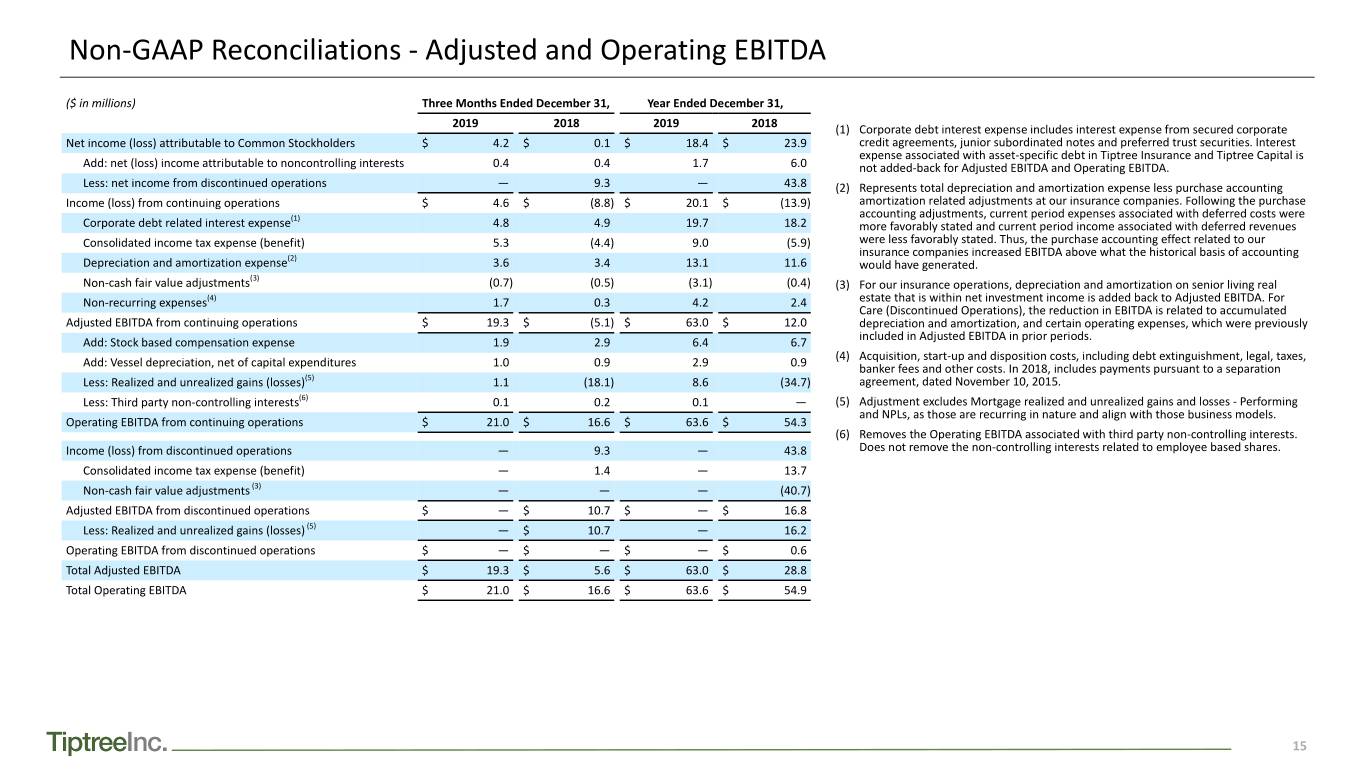
Non-GAAP Reconciliations - Adjusted and Operating EBITDA ($ in millions) Three Months Ended December 31, Year Ended December 31, 2019 2018 2019 2018 (1) Corporate debt interest expense includes interest expense from secured corporate Net income (loss) attributable to Common Stockholders $ 4.2 $ 0.1 $ 18.4 $ 23.9 credit agreements, junior subordinated notes and preferred trust securities. Interest expense associated with asset-specific debt in Tiptree Insurance and Tiptree Capital is Add: net (loss) income attributable to noncontrolling interests 0.4 0.4 1.7 6.0 not added-back for Adjusted EBITDA and Operating EBITDA. Less: net income from discontinued operations — 9.3 — 43.8 (2) Represents total depreciation and amortization expense less purchase accounting Income (loss) from continuing operations $ 4.6 $ (8.8) $ 20.1 $ (13.9) amortization related adjustments at our insurance companies. Following the purchase (1) accounting adjustments, current period expenses associated with deferred costs were Corporate debt related interest expense 4.8 4.9 19.7 18.2 more favorably stated and current period income associated with deferred revenues Consolidated income tax expense (benefit) 5.3 (4.4) 9.0 (5.9) were less favorably stated. Thus, the purchase accounting effect related to our (2) insurance companies increased EBITDA above what the historical basis of accounting Depreciation and amortization expense 3.6 3.4 13.1 11.6 would have generated. (3) Non-cash fair value adjustments (0.7) (0.5) (3.1) (0.4) (3) For our insurance operations, depreciation and amortization on senior living real Non-recurring expenses(4) 1.7 0.3 4.2 2.4 estate that is within net investment income is added back to Adjusted EBITDA. For Care (Discontinued Operations), the reduction in EBITDA is related to accumulated Adjusted EBITDA from continuing operations $ 19.3 $ (5.1) $ 63.0 $ 12.0 depreciation and amortization, and certain operating expenses, which were previously included in Adjusted EBITDA in prior periods. Add: Stock based compensation expense 1.9 2.9 6.4 6.7 (4) Acquisition, start-up and disposition costs, including debt extinguishment, legal, taxes, Add: Vessel depreciation, net of capital expenditures 1.0 0.9 2.9 0.9 banker fees and other costs. In 2018, includes payments pursuant to a separation Less: Realized and unrealized gains (losses)(5) 1.1 (18.1) 8.6 (34.7) agreement, dated November 10, 2015. Less: Third party non-controlling interests(6) 0.1 0.2 0.1 — (5) Adjustment excludes Mortgage realized and unrealized gains and losses - Performing and NPLs, as those are recurring in nature and align with those business models. Operating EBITDA from continuing operations $ 21.0 $ 16.6 $ 63.6 $ 54.3 (6) Removes the Operating EBITDA associated with third party non-controlling interests. Income (loss) from discontinued operations — 9.3 — 43.8 Does not remove the non-controlling interests related to employee based shares. Consolidated income tax expense (benefit) — 1.4 — 13.7 Non-cash fair value adjustments (3) — — — (40.7) Adjusted EBITDA from discontinued operations $ — $ 10.7 $ — $ 16.8 Less: Realized and unrealized gains (losses) (5) — $ 10.7 — 16.2 Operating EBITDA from discontinued operations $ — $ — $ — $ 0.6 Total Adjusted EBITDA $ 19.3 $ 5.6 $ 63.0 $ 28.8 Total Operating EBITDA $ 21.0 $ 16.6 $ 63.6 $ 54.9 15
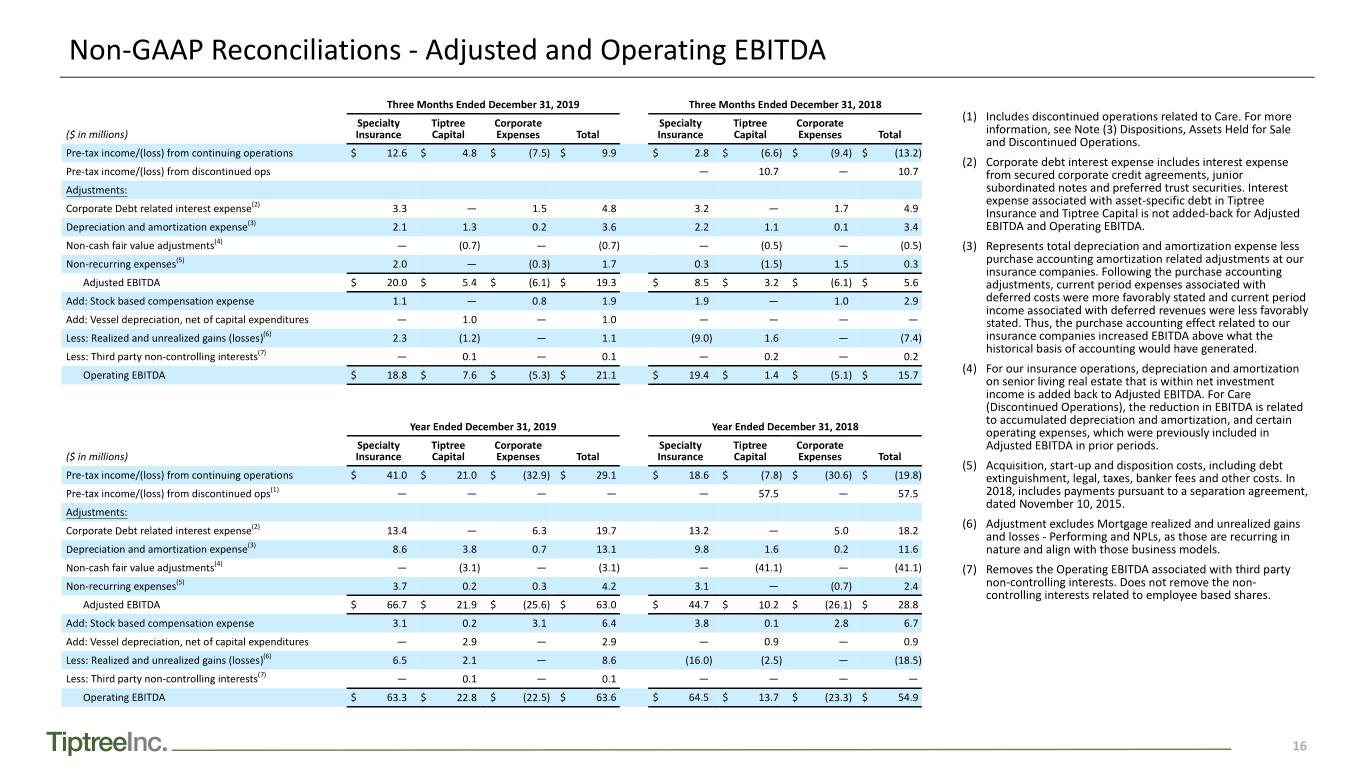
Non-GAAP Reconciliations - Adjusted and Operating EBITDA Three Months Ended December 31, 2019 Three Months Ended December 31, 2018 (1) Includes discontinued operations related to Care. For more Specialty Tiptree Corporate Specialty Tiptree Corporate ($ in millions) Insurance Capital Expenses Total Insurance Capital Expenses Total information, see Note (3) Dispositions, Assets Held for Sale and Discontinued Operations. Pre-tax income/(loss) from continuing operations $ 12.6 $ 4.8 $ (7.5) $ 9.9 $ 2.8 $ (6.6) $ (9.4) $ (13.2) (2) Corporate debt interest expense includes interest expense Pre-tax income/(loss) from discontinued ops — 10.7 — 10.7 from secured corporate credit agreements, junior Adjustments: subordinated notes and preferred trust securities. Interest (2) expense associated with asset-specific debt in Tiptree Corporate Debt related interest expense 3.3 — 1.5 4.8 3.2 — 1.7 4.9 Insurance and Tiptree Capital is not added-back for Adjusted Depreciation and amortization expense(3) 2.1 1.3 0.2 3.6 2.2 1.1 0.1 3.4 EBITDA and Operating EBITDA. Non-cash fair value adjustments(4) — (0.7) — (0.7) — (0.5) — (0.5) (3) Represents total depreciation and amortization expense less Non-recurring expenses(5) 2.0 — (0.3) 1.7 0.3 (1.5) 1.5 0.3 purchase accounting amortization related adjustments at our insurance companies. Following the purchase accounting Adjusted EBITDA $ 20.0 $ 5.4 $ (6.1) $ 19.3 $ 8.5 $ 3.2 $ (6.1) $ 5.6 adjustments, current period expenses associated with Add: Stock based compensation expense 1.1 — 0.8 1.9 1.9 — 1.0 2.9 deferred costs were more favorably stated and current period income associated with deferred revenues were less favorably Add: Vessel depreciation, net of capital expenditures — 1.0 — 1.0 — — — — stated. Thus, the purchase accounting effect related to our Less: Realized and unrealized gains (losses)(6) 2.3 (1.2) — 1.1 (9.0) 1.6 — (7.4) insurance companies increased EBITDA above what the historical basis of accounting would have generated. Less: Third party non-controlling interests(7) — 0.1 — 0.1 — 0.2 — 0.2 (4) For our insurance operations, depreciation and amortization Operating EBITDA $ 18.8 $ 7.6 $ (5.3) $ 21.1 $ 19.4 $ 1.4 $ (5.1) $ 15.7 on senior living real estate that is within net investment income is added back to Adjusted EBITDA. For Care (Discontinued Operations), the reduction in EBITDA is related to accumulated depreciation and amortization, and certain Year Ended December 31, 2019 Year Ended December 31, 2018 operating expenses, which were previously included in Specialty Tiptree Corporate Specialty Tiptree Corporate Adjusted EBITDA in prior periods. ($ in millions) Insurance Capital Expenses Total Insurance Capital Expenses Total (5) Acquisition, start-up and disposition costs, including debt Pre-tax income/(loss) from continuing operations $ 41.0 $ 21.0 $ (32.9) $ 29.1 $ 18.6 $ (7.8) $ (30.6) $ (19.8) extinguishment, legal, taxes, banker fees and other costs. In Pre-tax income/(loss) from discontinued ops(1) — — — — — 57.5 — 57.5 2018, includes payments pursuant to a separation agreement, dated November 10, 2015. Adjustments: (2) (6) Adjustment excludes Mortgage realized and unrealized gains Corporate Debt related interest expense 13.4 — 6.3 19.7 13.2 — 5.0 18.2 and losses - Performing and NPLs, as those are recurring in Depreciation and amortization expense(3) 8.6 3.8 0.7 13.1 9.8 1.6 0.2 11.6 nature and align with those business models. Non-cash fair value adjustments(4) — (3.1) — (3.1) — (41.1) — (41.1) (7) Removes the Operating EBITDA associated with third party Non-recurring expenses(5) 3.7 0.2 0.3 4.2 3.1 — (0.7) 2.4 non-controlling interests. Does not remove the non- controlling interests related to employee based shares. Adjusted EBITDA $ 66.7 $ 21.9 $ (25.6) $ 63.0 $ 44.7 $ 10.2 $ (26.1) $ 28.8 Add: Stock based compensation expense 3.1 0.2 3.1 6.4 3.8 0.1 2.8 6.7 Add: Vessel depreciation, net of capital expenditures — 2.9 — 2.9 — 0.9 — 0.9 Less: Realized and unrealized gains (losses)(6) 6.5 2.1 — 8.6 (16.0) (2.5) — (18.5) Less: Third party non-controlling interests(7) — 0.1 — 0.1 — — — — Operating EBITDA $ 63.3 $ 22.8 $ (22.5) $ 63.6 $ 64.5 $ 13.7 $ (23.3) $ 54.9 16
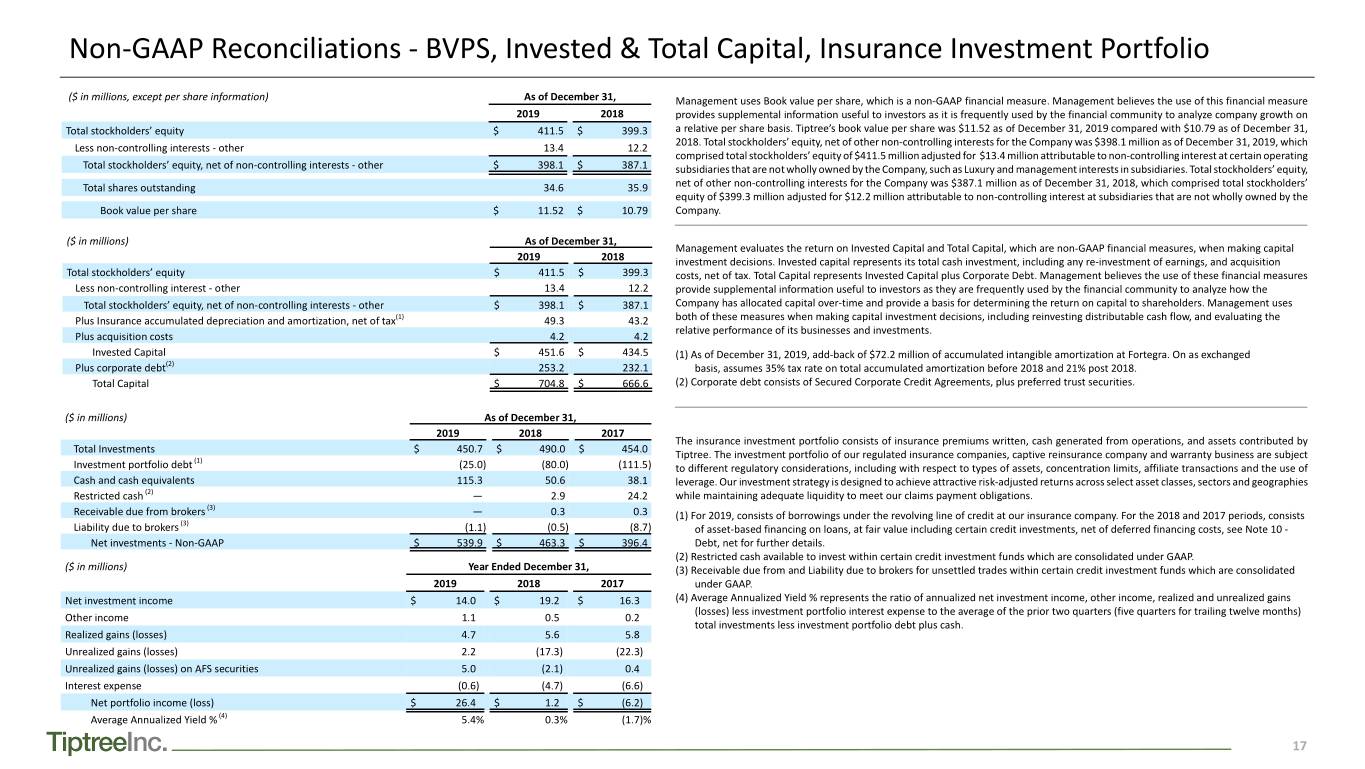
Non-GAAP Reconciliations - BVPS, Invested & Total Capital, Insurance Investment Portfolio ($ in millions, except per share information) As of December 31, Management uses Book value per share, which is a non-GAAP financial measure. Management believes the use of this financial measure 2019 2018 provides supplemental information useful to investors as it is frequently used by the financial community to analyze company growth on Total stockholders’ equity $ 411.5 $ 399.3 a relative per share basis. Tiptree’s book value per share was $11.52 as of December 31, 2019 compared with $10.79 as of December 31, 2018. Total stockholders’ equity, net of other non-controlling interests for the Company was $398.1 million as of December 31, 2019, which Less non-controlling interests - other 13.4 12.2 comprised total stockholders’ equity of $411.5 million adjusted for $13.4 million attributable to non-controlling interest at certain operating Total stockholders’ equity, net of non-controlling interests - other $ 398.1 $ 387.1 subsidiaries that are not wholly owned by the Company, such as Luxury and management interests in subsidiaries. Total stockholders’ equity, Total shares outstanding 34.6 35.9 net of other non-controlling interests for the Company was $387.1 million as of December 31, 2018, which comprised total stockholders’ equity of $399.3 million adjusted for $12.2 million attributable to non-controlling interest at subsidiaries that are not wholly owned by the Book value per share $ 11.52 $ 10.79 Company. ($ in millions) As of December 31, Management evaluates the return on Invested Capital and Total Capital, which are non-GAAP financial measures, when making capital 2019 2018 investment decisions. Invested capital represents its total cash investment, including any re-investment of earnings, and acquisition Total stockholders’ equity $ 411.5 $ 399.3 costs, net of tax. Total Capital represents Invested Capital plus Corporate Debt. Management believes the use of these financial measures Less non-controlling interest - other 13.4 12.2 provide supplemental information useful to investors as they are frequently used by the financial community to analyze how the Total stockholders’ equity, net of non-controlling interests - other $ 398.1 $ 387.1 Company has allocated capital over-time and provide a basis for determining the return on capital to shareholders. Management uses Plus Insurance accumulated depreciation and amortization, net of tax(1) 49.3 43.2 both of these measures when making capital investment decisions, including reinvesting distributable cash flow, and evaluating the relative performance of its businesses and investments. Plus acquisition costs 4.2 4.2 Invested Capital $ 451.6 $ 434.5 (1) As of December 31, 2019, add-back of $72.2 million of accumulated intangible amortization at Fortegra. On as exchanged Plus corporate debt(2) 253.2 232.1 basis, assumes 35% tax rate on total accumulated amortization before 2018 and 21% post 2018. Total Capital $ 704.8 $ 666.6 (2) Corporate debt consists of Secured Corporate Credit Agreements, plus preferred trust securities. ($ in millions) As of December 31, 2019 2018 2017 The insurance investment portfolio consists of insurance premiums written, cash generated from operations, and assets contributed by Total Investments $ 450.7 $ 490.0 $ 454.0 (1) Tiptree. The investment portfolio of our regulated insurance companies, captive reinsurance company and warranty business are subject Investment portfolio debt (25.0) (80.0) (111.5) to different regulatory considerations, including with respect to types of assets, concentration limits, affiliate transactions and the use of Cash and cash equivalents 115.3 50.6 38.1 leverage. Our investment strategy is designed to achieve attractive risk-adjusted returns across select asset classes, sectors and geographies Restricted cash (2) — 2.9 24.2 while maintaining adequate liquidity to meet our claims payment obligations. (3) Receivable due from brokers — 0.3 0.3 (1) For 2019, consists of borrowings under the revolving line of credit at our insurance company. For the 2018 and 2017 periods, consists (3) Liability due to brokers (1.1) (0.5) (8.7) of asset-based financing on loans, at fair value including certain credit investments, net of deferred financing costs, see Note 10 - Net investments - Non-GAAP $ 539.9 $ 463.3 $ 396.4 Debt, net for further details. (2) Restricted cash available to invest within certain credit investment funds which are consolidated under GAAP. ($ in millions) Year Ended December 31, (3) Receivable due from and Liability due to brokers for unsettled trades within certain credit investment funds which are consolidated 2019 2018 2017 under GAAP. Net investment income $ 14.0 $ 19.2 $ 16.3 (4) Average Annualized Yield % represents the ratio of annualized net investment income, other income, realized and unrealized gains (losses) less investment portfolio interest expense to the average of the prior two quarters (five quarters for trailing twelve months) Other income 1.1 0.5 0.2 total investments less investment portfolio debt plus cash. Realized gains (losses) 4.7 5.6 5.8 Unrealized gains (losses) 2.2 (17.3) (22.3) Unrealized gains (losses) on AFS securities 5.0 (2.1) 0.4 Interest expense (0.6) (4.7) (6.6) Net portfolio income (loss) $ 26.4 $ 1.2 $ (6.2) Average Annualized Yield % (4) 5.4% 0.3% (1.7)% 17
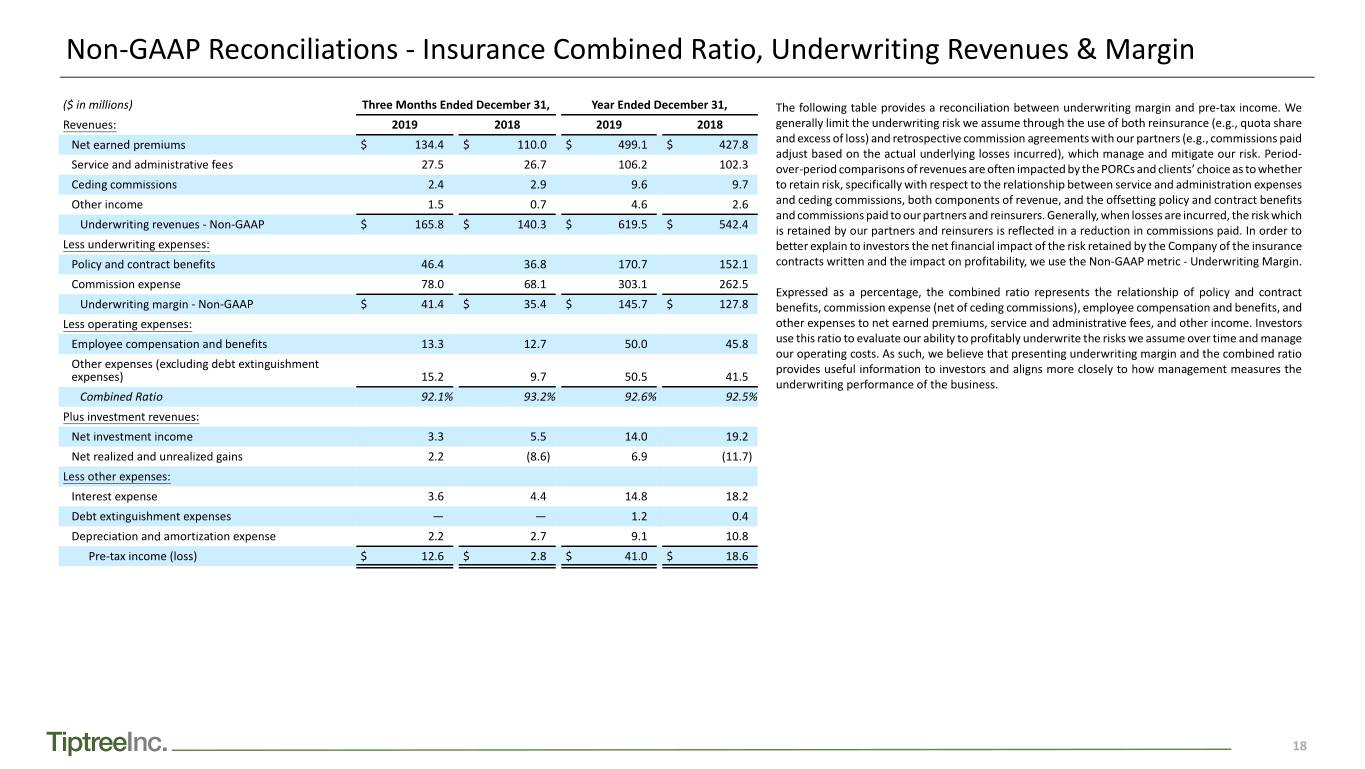
Non-GAAP Reconciliations - Insurance Combined Ratio, Underwriting Revenues & Margin ($ in millions) Three Months Ended December 31, Year Ended December 31, The following table provides a reconciliation between underwriting margin and pre-tax income. We Revenues: 2019 2018 2019 2018 generally limit the underwriting risk we assume through the use of both reinsurance (e.g., quota share Net earned premiums $ 134.4 $ 110.0 $ 499.1 $ 427.8 and excess of loss) and retrospective commission agreements with our partners (e.g., commissions paid adjust based on the actual underlying losses incurred), which manage and mitigate our risk. Period- Service and administrative fees 27.5 26.7 106.2 102.3 over-period comparisons of revenues are often impacted by the PORCs and clients’ choice as to whether Ceding commissions 2.4 2.9 9.6 9.7 to retain risk, specifically with respect to the relationship between service and administration expenses Other income 1.5 0.7 4.6 2.6 and ceding commissions, both components of revenue, and the offsetting policy and contract benefits and commissions paid to our partners and reinsurers. Generally, when losses are incurred, the risk which Underwriting revenues - Non-GAAP $ 165.8 $ 140.3 $ 619.5 $ 542.4 is retained by our partners and reinsurers is reflected in a reduction in commissions paid. In order to Less underwriting expenses: better explain to investors the net financial impact of the risk retained by the Company of the insurance Policy and contract benefits 46.4 36.8 170.7 152.1 contracts written and the impact on profitability, we use the Non-GAAP metric - Underwriting Margin. Commission expense 78.0 68.1 303.1 262.5 Expressed as a percentage, the combined ratio represents the relationship of policy and contract Underwriting margin - Non-GAAP $ 41.4 $ 35.4 $ 145.7 $ 127.8 benefits, commission expense (net of ceding commissions), employee compensation and benefits, and Less operating expenses: other expenses to net earned premiums, service and administrative fees, and other income. Investors Employee compensation and benefits 13.3 12.7 50.0 45.8 use this ratio to evaluate our ability to profitably underwrite the risks we assume over time and manage our operating costs. As such, we believe that presenting underwriting margin and the combined ratio Other expenses (excluding debt extinguishment provides useful information to investors and aligns more closely to how management measures the expenses) 15.2 9.7 50.5 41.5 underwriting performance of the business. Combined Ratio 92.1% 93.2% 92.6% 92.5% Plus investment revenues: Net investment income 3.3 5.5 14.0 19.2 Net realized and unrealized gains 2.2 (8.6) 6.9 (11.7) Less other expenses: Interest expense 3.6 4.4 14.8 18.2 Debt extinguishment expenses — — 1.2 0.4 Depreciation and amortization expense 2.2 2.7 9.1 10.8 Pre-tax income (loss) $ 12.6 $ 2.8 $ 41.0 $ 18.6 18
